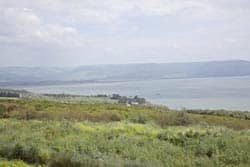More of the details and specific practices of the Passover will be examined later in relation to John's Last Supper narratives. At this point, however, we need to note two Passover themes that appear in John 6: bread and blood. Passover cannot be undertaken without unleavened bread or without pouring the blood from the sacrificial lamb on the altar. The Bread and Blood of Life are two Passover symbols used by Jesus in his discourse in the follow section (Jn. 6:25-51), which I'll discuss next week. As a final observation, Passover was a time when the Jews brought food—lamb, bread, and blood—to God in his temple. In John 6, God, incarnate as Jesus, paradoxically brings the Passover meal to God's people.
The Reaction of the People (6:14-15)
John also uniquely adds a brief notice to this story describing the reaction of the people to this miracle. "When the people saw the sign which he had done, they said, 'This is indeed the prophet who is to come into the world!'" (Jn. 6:14). This passage gives us the clue to John's ultimate point—that this miracle is a sign that Jesus is the Prophet like Moses described in Deuteronomy 18:15, 18. John is emphasizing that Jesus performed the same type of miracles that Moses did.
Specifically John is drawing parallels to Moses, who provided miraculous manna/bread and quail/meat in the wilderness (Num. 11; cf. Elisha in 2 Kgs. 4:42-44). Here Jesus provides miraculous bread and fish. Step by step John is developing his case not just that Jesus can perform miraculous signs, but that these signs precisely parallel the types of signs that had been performed by Moses, thus showing Jesus to be the expected prophet like Moses.
 This miracle of feeding the 5,000 concludes in John with verse 15 where Jesus flees into "the mountain" when faced by people who want to "take him by force to make him king" (6:15). Paradoxically, this is precisely what Jesus proclaims—that he is king messiah (1:49, 12:13, 18:37). And, indeed in chapter 12:13 he accepts the mass royal acclamation that he is here avoiding.
This miracle of feeding the 5,000 concludes in John with verse 15 where Jesus flees into "the mountain" when faced by people who want to "take him by force to make him king" (6:15). Paradoxically, this is precisely what Jesus proclaims—that he is king messiah (1:49, 12:13, 18:37). And, indeed in chapter 12:13 he accepts the mass royal acclamation that he is here avoiding.
Why does he reject this acclamation at this time? It is possibly because at this point in chapter 6 "his hour had not yet come" (7:30, 8:20); while by chapter 12 his "hour has come" (12:23). It may also be, however, that Jesus is attempting to avoid an insurrection created by rebels seeking to promote Jesus as a militant messiah. In either case Jesus fled the very crowds whom he had just convinced that he was "indeed the Prophet" (16:14).
 As I shall discuss later, John's overall point here is that while Jesus is the true Messiah, many people were expecting a different type of Messiah. This disjunction between reality of Jesus as Messiah and the widespread contemporary expectation of a militant Messiah is part of the reason for the developing crisis that will culminate in Jesus' execution. While Jesus claims to be the Messiah, he fails in what was expected of the militant Messiah: the liberation of Israel and the reestablishment of the political Davidic kingdom. When Jesus fails to fulfill this expectation, many who initially saw him as the anointed king ultimately reject him, which helps to explain the paradox of the Messianic acclamation at the triumphal entry into Jerusalem, followed by the same people rejecting him as king messiah only a few days later—a topic to which I'll return.
As I shall discuss later, John's overall point here is that while Jesus is the true Messiah, many people were expecting a different type of Messiah. This disjunction between reality of Jesus as Messiah and the widespread contemporary expectation of a militant Messiah is part of the reason for the developing crisis that will culminate in Jesus' execution. While Jesus claims to be the Messiah, he fails in what was expected of the militant Messiah: the liberation of Israel and the reestablishment of the political Davidic kingdom. When Jesus fails to fulfill this expectation, many who initially saw him as the anointed king ultimately reject him, which helps to explain the paradox of the Messianic acclamation at the triumphal entry into Jerusalem, followed by the same people rejecting him as king messiah only a few days later—a topic to which I'll return.
Walking on the Sea of Galilee (Jn. 6:16-21)
In this passage Jesus performs his most parodied miracle: walking on water. Like the feeding of the 5,000, this story is found in both John and the synoptic Gospels (Mt. 14:22-33; Mk. 6:45-52; Jn. 6:16-21; though only Matthew contains the story of Peter's walk). For John this passage has two meanings. First, it is simply another miracle or sign demonstrating Jesus' divinity, since walking on water is a physical impossibility. At their most basic level, all of Jesus' miraculous signs are demonstrations of his divine power and authority, and this one terrifies the disciples (6:19). It was not, however, a sign aimed at the conversion of the masses, since it was seen only by a few of the disciples who were riding in the boat.
Remembering, however, that John is emphasizing in this chapter that Jesus is "indeed the prophet who is to come into the world"—that is, the prophet like Moses (Dt. 18:15, 18)—John has a more subtle point to make. While Moses never walked on water, Moses did control the waters and cause the children of Israel to miraculously cross the Red Sea (Ex. 14-15). Joshua and Elijah later performed similar miracles when crossing the Jordan River (Josh. 3; 2 Kgs. 2:8). So, just as Moses led Israel to salvation by miraculous control of the sea, so Jesus likewise miraculously crosses the sea to bring salvation to Israel.





